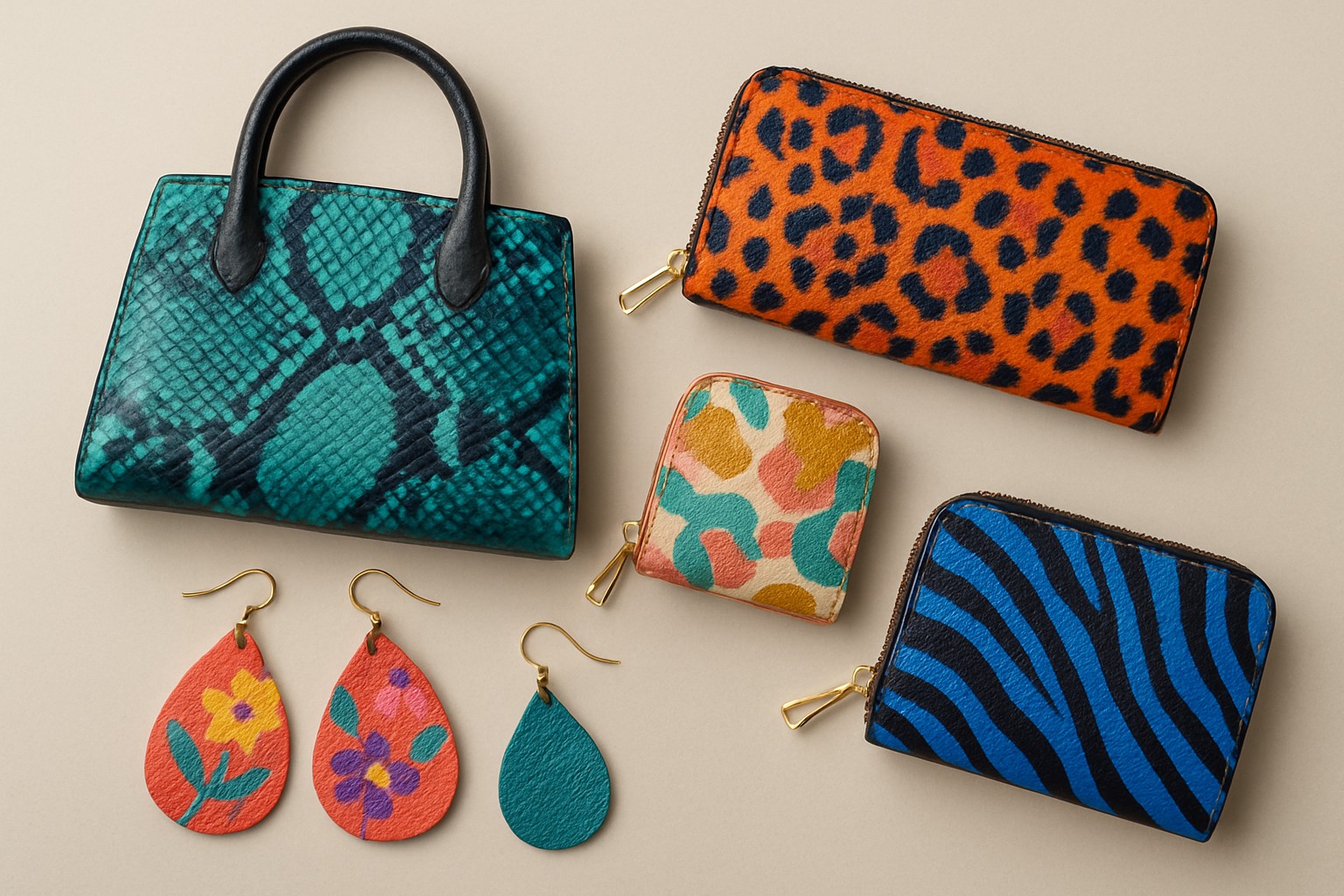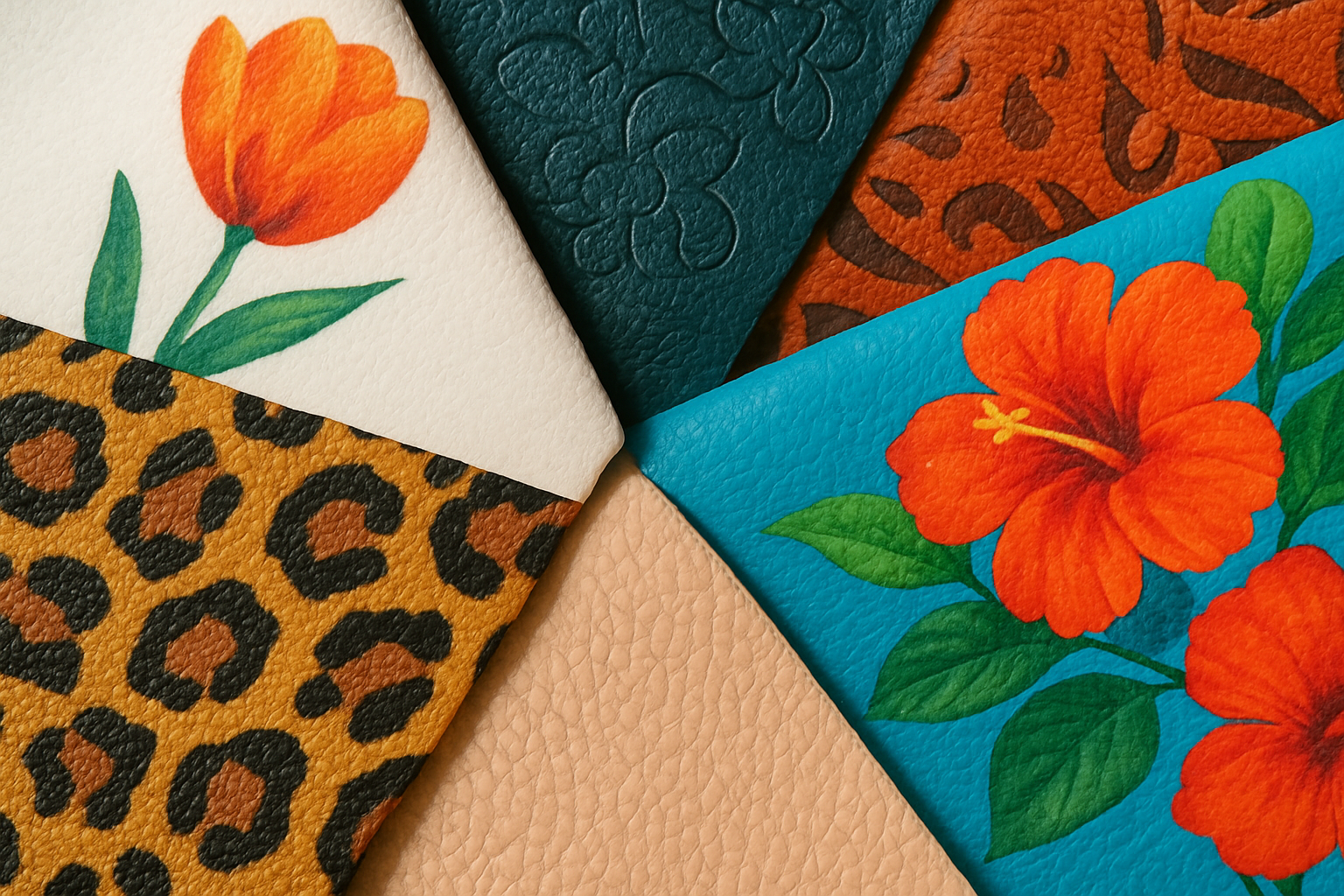Printed Artificial Leather - Buying Guide For Fashion And Crafts

Printed artificial leather has won over many fans in the fashion and crafting worlds and it’s easy to see why. Unlike traditional leather this material flaunts a dazzling variety of patterns and textures. It gives creatives the freedom to take risks with bold designs while keeping a clear conscience about ethics. This buying guide dives into printing techniques and material types plus some handy tips tailored to a wide range of projects.
What Does Printed Artificial Leather Actually Mean?
It comes decked out in printed patterns or textures. Unlike genuine leather it’s crafted from man-made fabrics like polyurethane (PU) or polyvinyl chloride (PVC). These materials usually carry intricate designs applied through clever techniques such as digital or screen printing or heat transfer printing.
Different Kinds of Printed Artificial Leather
When it comes to printed artificial leather, there’s quite the colorful palette to choose from. Whether you’re after bold patterns or subtle textures, the options really run the gamut. Let’s take a closer look at these varieties and see what makes each one stand out—because sometimes, the devil’s in the details.
Printed artificial leather comes in a handful of varieties mostly set apart by their base materials and how they are finished. You’ll often see PU leather which usually feels soft and breathable and pretty comfortable. Then there’s PVC leather which is tougher and more durable but can be a bit stiff compared to others. On top of that, microfiber-based printed leathers offer a richer texture and tend to be kinder to the environment which is always a nice bonus.
| Material Type | Durability | Print Quality | Flexibility | Typical Uses |
|---|---|---|---|---|
| PU Leather | Moderate | High (Vibrant Colors) | High | Fashion apparel, bags, and light upholstery that gently wear in over time |
| PVC Leather | High | Moderate | Low | Built tough for outdoor gear and heavy-duty upholstery that can take a beating |
| Microfiber-based Leather | High | High (Fine Details) | Moderate | Premium crafts, footwear, and garments with that extra touch of finesse |
| Embossed Printed Leather | Moderate to High | Textured Print | Moderate | Luxury accessories and standout pieces that really catch the eye |
| Flat Printed Leather | Moderate | Smooth Print | High | Versatile fashion items and crafts that flex with your style and needs |
Knowing these differences can really steer you toward the best printed artificial leather for your project. PU leather usually shines when it comes to flexible fashion pieces, giving you that comfortable yet stylish vibe. On the flip side, PVC’s durability makes it a reliable choice for upholstery that’s built to stand the test of time. Embossed prints add that extra pop of visual depth, often catching the eye for bold statement accessories.
Important Features and Specifications to Keep in Mind (Because They Really Matter!)
- Clear print quality and good color retention keep your designs sharp and vibrant for the long haul
- Texture and surface feel play a big role in both the look and how it feels in your hands
- Durability and resistance to wear give the product a better shot at lasting without falling apart
- Thickness and weight affect comfort and how easy or tricky it is to handle
- Eco-friendliness and material origin highlight important ethical choices
- Price that hits the sweet spot between quality and what your wallet can handle
Each feature contributes to shaping your experience with printed artificial leather. High print clarity keeps designs looking sharp and fresh, almost like they just came off the press. Durable materials ensure your item lasts through many uses, which is a relief. Texture is not just about looks—it’s what you actually feel when you touch it, making a big difference. Choosing eco-friendly options is a great way to support sustainable fashion without any extra effort.
Printing Techniques and Common Patterns A Quick Dive Into the Basics
Printed artificial leather often comes to life through a variety of printing techniques. You have digital printing which serves up vibrant and detailed patterns that catch the eye. Then there’s screen printing known for bold and repetitive designs that don’t shy away from making a statement. Heat transfer delivers sharp and long-lasting images that stand their ground over time. Embossing adds a tactile dimension with raised textures you can actually feel. When it comes to patterns, the usual suspects like animal prints—think leopard and snakeskin—are always popular. But there’s also a rich mix of florals, sleek modern geometric shapes and playful prints inspired by abstract art.

The printing method you pick plays a big role in how your material holds up and what it’s designed for. Digital prints usually nail the finer details and work well for fashion items with intricate patterns that catch the eye. Screen printing shines in durability, especially on accessories and upholstery that see more wear and tear. Embossed finishes add a lush texture you can almost feel.
The Ups and Downs of Printed Artificial Leather
- Its affordability compared to genuine leather often makes it a go-to choice for many budgets that cannot stretch too far
- Offers a surprising amount of versatility in design and uses which opens the door to plenty of creative possibilities
- Being cruelty-free and often more sustainable than animal leather is definitely a win in anyone’s book
- Maintenance tends to be a breeze and usually just needs some simple cleaning to keep it looking fresh
- Lower breathability can sometimes put a damper on comfort especially in certain types of clothing where airflow matters
- There are potential environmental concerns when it’s made from plastics that aren’t recyclable which is something to keep in mind
- Over time it might start showing signs of wear like peeling or surface damage, nothing too shocking but worth noting
Printed artificial leather comes with quite a few perks, like being the more ethical choice and opening the door to all kinds of creative designs. It’s important to remember a couple of downsides—its breathability isn’t exactly stellar, and there are some environmental concerns linked to the plastics involved.
Tips for Choosing Printed Artificial Leather for Your Fashion Projects
Finding the right printed artificial leather can sometimes feel like hunting for a needle in a haystack, but with a little know-how, you’ll be turning heads in no time. Whether you’re diving into your first project or a seasoned pro, these tips will help you pick the perfect material that not only looks fantastic but also wears well. Let’s jump right in and make your fashion ideas come to life with the best faux leather out there.
When picking printed artificial leather for fashion pieces, it’s worth pausing to consider the type of garment and the kind of flexibility you want. Also think about comfort levels, how easy it’ll be to care for, and how long you want it to last. Lightweight stretchy printed PU leather works well for jackets or skirts. Thicker embossed varieties shine when used for structured bags or eye-catching outerwear.
Take a good look at your project's unique needs—think about the type of garment and how it is going to be worn.
Give some thought to the print quality and how it feels because you want those two to really click with the look and comfort you’re aiming for.
Check out the material’s durability and flexibility since it needs to move with you and hold up over time. No shortcuts there.
Weigh ethical and environmental factors, as where your material comes from and its sustainability matter more than you might think.
Set a budget that’s realistic. It is all about striking a balance between quality and what won’t make your wallet scream.
How to Choose Printed Artificial Leather for Your Crafts and DIY Projects Without Breaking a Sweat
When diving into craft and DIY projects it is usually smart to pick printed artificial leather that is easy to cut and shape without fraying or cracking. If you are thinking about gluing pieces together, double-check that the adhesive works well with the material—no one wants their masterpiece falling apart. The print should also stand up to handling, sunlight, and occasional washing without losing its charm.
- Stay flexible and won’t crack or peel when you cut them
- Hold up well through regular handling and crafting, so your hard work doesn’t fade away after just a few uses.
- Fits the vibe you’re going for, whether that’s silky smooth or with a bit of a grainy charm.
- Keep an eye on the price per yard, because even the most creative projects need a budget to stay on track.
- Hunting for environmentally friendly options never hurts it feels good knowing your crafts don’t cost the Earth.
Budgeting A Friendly Guide to Pricing and What Goes into Costs
Prices for printed artificial leather can swing quite a bit depending on the type of material and how fancy the print gets. The manufacturing process and the brand’s clout also affect cost. PU leather with straightforward prints usually comes in on the cheaper side and is a solid choice if you’re watching your budget. Meanwhile, microfiber options and embossed patterns tend to lean toward the pricier end because of their nicer quality and luxurious feel. Production techniques like digital printing add a bit to the bill but often pay off with sharper, more detailed results.
| Type of Artificial Leather | Average Cost per Yard/Meter | Quality Tier | Typical Uses | Where to Buy |
|---|---|---|---|---|
| PU Leather with Flat Print | $8 - $20 | Mid | Fashion clothing, small crafts | Online fabric stores, wholesalers - your go-to spots for a quick grab |
| PVC Leather | $6 - $15 | Budget to Mid | Upholstery, outdoor products | Wholesale fabric suppliers, craft shops - perfect for those who like a good bargain |
| Microfiber Printed Leather | $18 - $40 | High | Premium clothing, footwear | Specialty fabric boutiques, eco-conscious brands - because quality and sustainability matter |
| Embossed Printed Leather | $20 - $50 | Premium | Luxury accessories, standout pieces | Designer wholesalers, premium retailers - where top-tier meets style |
Places to Buy Printed Artificial Leather That’ll Make You Do a Double Take
Printed artificial leather pops up all over the place these days—from major online marketplaces to specialty fabric shops plus wholesale distributors and suppliers who keep sustainability front and center. Each spot has its own charm with varying perks and quirks around selection, pricing and the kind of quality guarantees you can expect.
- Online marketplaces offer a smorgasbord of options but usually require a careful once-over to make sure you’re not biting off more than you can chew on quality.
- Specialty fabric stores often come with the bonus of expert advice and top-notch materials, though their prices can be a bit of a wallet pinch.
- Wholesale distributors shine when you’re after large quantities, often serving up better deals that can make your accountant smile.
- Suppliers focused on sustainable materials cater to those who want to tread lightly on the planet, but keep in mind their products might carry a bit of a premium tag.
- Double-check return policies and see how quick and helpful customer service is before clicking that purchase button.
Tips for Maintaining and Caring for Printed Artificial Leather
Taking good care of printed artificial leather goes a long way in keeping it looking fresh and vibrant for much longer. Giving it a regular wipe-down with mild, non-abrasive cleaners not only helps preserve the print's crispness but also keeps things looking sharp. Stashing it away from direct sunlight is a little trick that really cuts down on fading over time.
- Give your items a gentle once-over now and then with a soft damp cloth and some mild soap. Avoid harsh chemicals because they can really damage the prints.
- Skip bleach, alcohol or abrasive cleaners since they might seem like a quick fix but often cause more harm by messing with delicate prints.
- Stash your pieces in cool dry spots ideally covered to keep dust and sunlight from spoiling them.
- Try your best not to fold printed surfaces because that can lead to cracking or distortion over time.
- Every so often show your artificial leather some love with conditioners or protectants made for it. This helps it stay soft and flexible instead of stiffening up on you.





